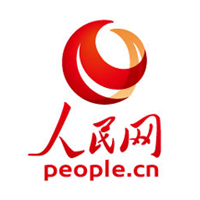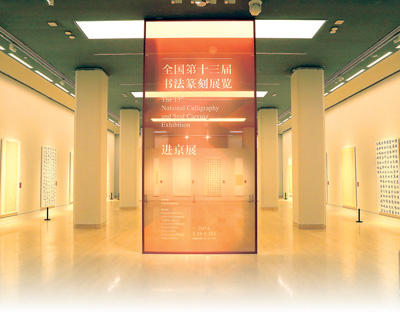 |
The scene of the "13th National Calligraphy and Seal Cutting Exhibition in Beijing" at the National Art Museum of China. |
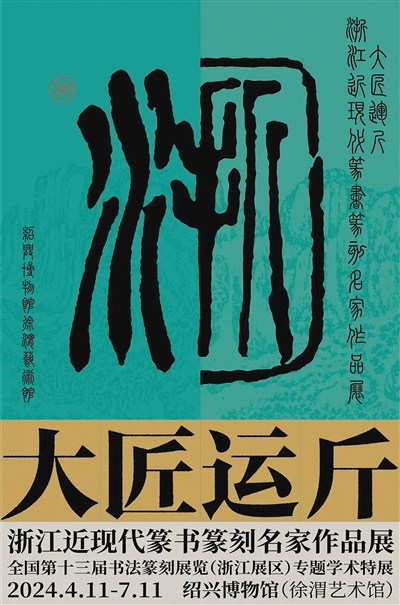 |
The poster of "Great Craftsmanship Brings Weight to Work - Zhejiang Modern Seal Calligraphy and Engraving Masters Exhibition" in Shaoxing Museum, Zhejiang Province. |
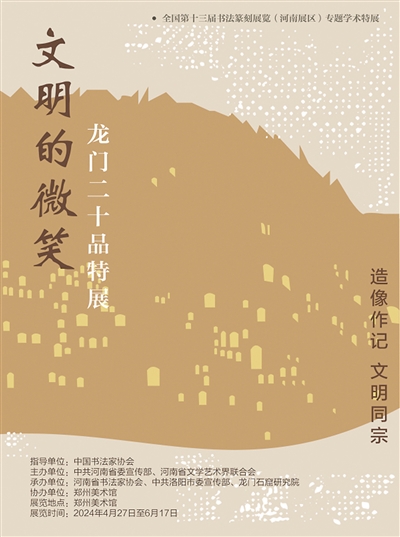 |
The poster of "Civilized Smile - Longmen 20 Product Special Exhibition" in Zhengzhou Art Museum (New Museum), Henan Province. |
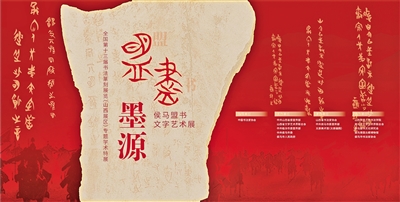 |
The poster of "ink source of alliance book - Houma alliance letter art exhibition" in Taiyuan Art Museum, Shanxi Province. |
Go to a city for an exhibition!
This is a hot topic on the 2024 International Museum Day, and also a true portrayal of the upsurge of "the 13th National Calligraphy and Seal Cutting Exhibition".
During the May Day holiday, many calligraphers and calligraphers went to Taiyuan, Shanxi, Shaoxing, Zhejiang, and Zhengzhou, Henan to watch the exhibitions carefully prepared in the three exhibition areas. On May 18, with the opening of the "13th National Calligraphy and Seal Cutting Exhibition in Beijing" sponsored by the Chinese Calligrapher's Association in the National Art Museum of China, this upsurge of exhibition viewing poured into Beijing and the grand occasion reappeared.
New dimension of classical thinking
Classical calligraphy is an important symbol of Chinese culture. The rediscovery of the value and significance of classics and the subjective strengthening of the awareness of classic creation have made this exhibition a cultural feast of harmony between ancient and modern times, leading the audience to embark on a journey of tracing the roots of Chinese culture, as well as an artistic journey of surveying the panorama of contemporary calligraphy and seal cutting.
There are three exhibition areas divided by book style, displaying nearly 1000 selected works, which are reflected in three national famous artists' invitation exhibitions and seven special academic exhibitions held in the same period, each with its own characteristics and integration. As Li Xin, a member of the Party Leadership Group of the China Federation of Literary and Art Circles, the secretary of the Party Leadership Group of the Chinese Calligraphy Association Branch and the vice-chairman of the Conference, said, holding the "13th National Calligraphy and Seal Cutting Exhibition" is an important measure to promote the high-quality development of calligraphy in the new era, aiming to guide the majority of calligraphers to actively participate in the great historical process of Chinese modernization with classic awareness and contemporary position as their creative direction, Promote the creative transformation and innovative development of calligraphy and seal cutting art.
The 236 pieces of running script, 181 pieces of cursive script, and 58 pieces of works by famous artists displayed in Shanxi Provincial Exhibition Hall show the overall style of diverse selection and mutual reference between steles and calligraphy. Starting from the word "source", the local government launched three special exhibitions in Shanxi Bronze Museum, Taiyuan Municipal Museum and Taiyuan Art Museum, namely, "True Source of Mountain - Fushan Calligraphy Art Exhibition", "Traces to the Origin of Weibei - Weibei Calligraphy Art Exhibition in Pingcheng Period", "Ink Source of Allied Calligraphy - Houma Allied Calligraphy Art Exhibition", to interpret Fushan's art and life from a new perspective It is the first time to comprehensively study and display more than 100 pieces of Weibei calligraphy relics in the Pingcheng period of the Northern Wei Dynasty, and systematically analyze the handwriting, calligraphy, and organization of the Jin characters in the Spring and Autumn Period, so as to achieve academic breakthroughs in the historical tracing.
The 86 pieces of seal script, 75 pieces of seal cutting, 33 pieces of lettering, and 52 pieces of works by famous artists on display at the Lanting Calligraphy Museum in Shaoxing, Zhejiang Province, present a new overall style. The corresponding special exhibition "Great Craftsmanship - Zhejiang Modern and Contemporary Seal Cutting Masters' Works Exhibition" was held in Shaoxing Museum. Through the exhibition of Zhao Zhichen, Xu Sangeng, Zhao Zhiqian, Wu Changshuo, Huang Binhong, Ma Yifu, Sha Menghai and other famous works, it systematically combed the context and pattern of various styles of Zhejiang modern and contemporary seal cutting. The seal script and seal cutting works in different periods reflect each other, so that the audience can more intuitively feel the historical integration and "integration" of seal script and seal cutting.
The 132 official script, 215 regular script and 55 works of famous artists on display in Zhengzhou Art Museum (New Museum) of Henan Province present the overall style of combination of tablet and bamboo script and combination of law and temperament. The "Central Plains of Chinese Characters - Han Sanque and Henan Han Stele Special Exhibition", "Smile of Civilization - Longmen 20 Product Special Exhibition", "From Legality to Interest - Thousand Tang Zhizhai Tang and Song Stele Special Exhibition", respectively, 24 rubbings of the "Song Mountain Han Sanque", the only existing temple in the Eastern Han Dynasty, 20 rubbings of Henan Han Stele, and the most representative "Longmen 20 Product" in Longmen Grottoes inscription 60 rubbings, 90 square epitaphs from the Sui Dynasty to the Song Dynasty in the Thousand Tang Zhizhai Museum, intuitively show the profound history and culture of the Central Plains.
Calligraphy classics of different styles provide continuous spiritual nourishment for contemporary calligraphers to learn from the past and create new ones. Contemporary masterpieces also endow traditional writing forms with new ways of expression. The two reflect each other, showing the trend of integration of creative practice and theoretical research, and highlighting the practical significance and academic connotation of the exhibition.
New Writing of the Light of the Times
The comprehensiveness of calligraphy and the special "stickiness" between ancient and modern times are fully reflected in the exhibition.
Since the new era, the discipline status of calligraphy has been constantly improved. "Fine Arts and Calligraphy" has officially become a first-class discipline. The "calligraphy craze", especially the "calligraphy education craze" has been constantly upgraded, demonstrating the strong vitality of the excellent traditional Chinese culture. However, calligraphy, like art, is regarded as the attribute cognition of "visual art", which makes calligraphy creation "pay more attention to pen and ink than text", "pay more attention to specialty than popularization" and other phenomena. How to make calligraphy better integrated into the times and life, and write the spirit of the new era? The academic community explored in many ways.
It is a fine tradition of Chinese calligraphy to have both art and literature, and it is also a realistic requirement for contemporary calligraphy creation. Since the new era, in view of the fact that calligraphy has gradually separated from life writing and weakened the function of "recording words and history" in the era, the Chinese Calligrapher's Association has put forward the concept of "rooting in tradition, encouraging innovation, having both art and literature, and being diverse and inclusive", focused on giving play to the function of calligraphy to express feelings and record words and history, and carried out a series of thematic creative practice activities, Guide the calligraphers to tell Chinese stories with their pens, and set up a "text review team" for the review of exhibition works. These measures have been strengthened and expanded in this exhibition. In addition, the exhibition also focuses on reforming the organizational model, optimizing the evaluation method and innovating the exhibition form. The preliminary evaluation work is in the charge of members of all groups, which has greatly stimulated the enthusiasm of authors from all over the country to contribute, and ensured the full coverage of selected works in all administrative regions. The electronic evaluation method and the adoption of high-tech and intelligent means of name pasting system ensure the fairness and transparency of the selection. A series of measures have opened a new model for selecting excellent works.
From the exhibition works, it can be seen that it is still the mainstream to express what we have learned, thought and feeling through excerpts of ancient poems and essays. Self writing is encouraged, and the text writing with the flavor of the times has aroused the emotional resonance of the audience; The creators pay more attention to the relationship between "art" and "literature", and pay more attention to the problems of characters, texts and running style. The common errors in the conversion of complex and simplified characters, text errors and omissions, broken sentences, running style against the calligraphy and other phenomena are greatly reduced. According to Li Gangtian, the jury and deputy director of the review committee of this exhibition, the premise for the reduction of diction errors is that at least one third of the submitted works are eliminated due to text and character problems. From this perspective, the overall cultural literacy and writing skills of calligraphy creators still need to be improved.
The art of calligraphy is reflected in the competition on the tip of the pen. In the final analysis, it is the competition of the creators' learning and cultivation. Under the guidance of the creation concept of "Wen Mo Tong Hui", the majority of calligraphers have a profound understanding of the cultural character of calligraphy, re-examine ancient poetry and prose with contemporary aesthetics, and endow ancient poetry and prose with a new ink form; Conceive the text with a creative attitude of going deep into life and writing the times, let the traditional pen and ink merge with the vocabulary of the times, deeply plant the cultural foundation of contemporary calligraphy creation, and enrich the spirit of contemporary calligraphy creation.
A New World of the Beauty of Chinese Characters
A history of calligraphy and seal cutting is also a history of constantly opening up new artistic boundaries. It is the only rule for the inheritance and development of calligraphy and seal cutting art to keep the right and create the new.
The works of this exhibition are rooted in tradition, diversified in style, and full of the flavor of the times, which reflects the achievements of the majority of calligraphers in recent years in keeping upright and bringing forth new ideas, activating and using cultural and museum resources to enrich the writing language, and reflects the phased characteristics of the current calligraphy and seal cutting creation, such as pursuing elegant and upright writing style, paying attention to natural writing, and strengthening academic and rational research, as well as the aesthetic orientation of fresh, natural, simple and vigorous. In terms of composition of authors, the youth creative group accounts for nearly 40%, and the youngest author is only 18 years old, injecting new vitality into artistic creation.
"Yinzong Qin and Han Dynasties" has always been the artistic proposition of seal cutting creation, and is also the basic idea of the Chinese Calligrapher's Association to promote the development of seal cutting art. On this basis, creative traditions such as "printing from books" represented by Deng Shiru in the Qing Dynasty, "printing from knives" represented by Zhejiang School, and "printing from outside" represented by Zhao Zhiqian in the Qing Dynasty have also been carried forward, realizing the integration of creative ideas. In this exhibition, different genres and styles of seal cutting art were fully displayed. In the opinion of Liu Hongyang, a judge, most of the seal cutting works have made pioneering exploration to varying degrees, and the number of freehand brushwork seal is obviously more than that of Gongwen seal, which also reflects the seal cutting creators' deliberate pursuit of artistry and unique understanding of the expression of the seal cutting art era. Gongwen printing is exquisite and elegant, and freehand printing is rich in changes. The printing screen with various forms and exquisite craftsmanship attracted many visitors at the exhibition site, fully demonstrating the new thinking of "taking the past as a teacher and turning the past into me".
The emerging art of lettering is an expansion of traditional calligraphy, adding a lot of modern flavor to the exhibition. In the long history, inscriptions on bones and tortoise shells, bronze inscriptions, and steles have precipitated a rich tradition of lettering. The art of lettering is an independent art form that gradually forms on the basis of traditional lettering to re express the art of calligraphy. For more than 30 years, from the theme engraving to the meaning and shape engraving, through the unremitting exploration of calligraphy and seal cutting artists, the modern engraving art with Chinese style and characteristics of the times has developed its own style in the international engraving arts and become a bridge between China and the world. In the lettering art part of this exhibition, "comprehensive material" works were added. Therefore, wood, pottery, porcelain, brick, stone, metal, etc. are all covered in the exhibition contributions, especially pottery and porcelain works, as well as works using multiple materials, accounting for a considerable proportion. Judges Wang Zhian, Li Guiyang and Shen Yansong believed that from the quality of calligraphy (material), the conception of form, to the overall artistic level, the artistic works of lettering have improved significantly compared with the last session. The broadening of the carrier drives the creators to carry out all-round experimental exploration in the composition, techniques, colors and other aspects of the works. In the future, there will be a long way to go for the art of self writing and self engraving to maintain artistic purity and avoid the tendency of craftsmanship, so as to form different genres of Chinese lettering.
The books and inscriptions are of the same origin, and the knives and pens are cultivated together. Every national calligraphy and seal cutting exhibition carries the social expectation and the great trust of the times. As Sun Xiaoyun, chairman of the Chinese Calligrapher's Association, said, we live in an era that connects the past and ushers in the future. It is hoped that every participating author will take this exhibition as an opportunity to devote himself to the times with excellent pen and ink, devote himself to the times with full enthusiasm, forge ahead, uphold integrity and bring forth new ideas, make great efforts to leave a strong and brilliant mark in the long scroll of the times, make his own efforts to promote the spread of Chinese calligraphy at home and abroad, and let Chinese calligraphy integrate into life and go global!
The pictures in this article are provided by the Chinese Calligrapher's Association
Layout design: Cai Huawei
People's Daily (May 27, 2024, 20th Edition)
(Editor in charge: Zhao Xinyue, Yuan Bo)
Share to let more people see





